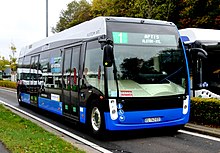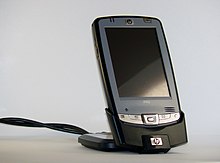
Conductive charging is conductive power transfer that replaces the conductive wires between the charger and the charged device with conductive contacts. Charging infrastructure in the form of a board or rail delivers the power to a charging device equipped with an appropriate receiver, or pickup. When the infrastructure recognizes a valid receiver it powers on, and power is transferred.
Phones and other electronic devices

Conductive power transfer uses electrical contacts to connect a power supply to a portable device in order to transfer energy. The technology is sometimes called "conductive wireless charging". The need for a conductor-to-conductor connection between the power supply and the device is the main difference from inductive charging and other forms of wireless charging. The conductive power supply, often a charging base or pad, detects when a compatible receiver or pickup is placed on it. Contact-based accessories may include changeable backs for cellular phones, special sleeves, or attachable clips. The charging bases are designed to identify a compatible receiver and only power up when it's detected to avoid risk of electrocution. Open Dots is a specification for such charging pads and receivers using contacts instead of wires.
Electric vehicles

Sweden has tested electric road systems that charge the batteries of private electric vehicles, and among the tested systems are two ground-level power supply systems that began testing in 2017. The in-road rail system is planned to deliver up to 800 kW per vehicle traveling over a powered segment of the rail, and the system is estimated to be the most cost-effective among the four tested systems. The new systems are expected to be safe, with segments of the rail being powered only when a vehicle is traveling over them. The rails have been tested while submerged in salt water and were found to be safe for pedestrians.
The European Commission published in 2021 a request for regulation and standardization of electric road systems. Alstom and other companies have, in 2020, begun drafting a standard for ground-level power supply electric roads. The first standard for electrical equipment on-board a vehicle powered by a rail electric road system (ERS), CENELEC Technical Standard 50717, has been approved in late 2022. Following standards, encompassing "full interoperability" and a "unified and interoperable solution" for ground-level power supply, are scheduled to be published by the end 2024, detailing complete "specifications for communication and power supply through conductive rails embedded in the road".
Companies
Honda started developing in the late 2010s a conductive charging system for electric vehicles, with 100 kW of power at a vehicle speed of 70 km/h (43 mph). As of 2021 Honda is testing 450 kW systems at vehicle speeds of 200 km/h (124 mph). The Swedish company Elways demonstrated in 2021 automatic power delivery of 960 kW to electric trucks, and hopes electric trucks in logistics loading docks and electric aircraft would be able to receive megawatts of power using this technology. ABB announced in 2021 that it is involved in the construction of the first permanent electric road that powers private vehicles and commercial vehicles such as trucks and buses, using ground-level power supply technology.
See also
References
- Ashley Carman (June 15, 2016), "Conductive wireless charging might be the future", The Verge
- Boehret, Katherine (16 February 2011). "It's hard to cut the charging cord". The Wall Street Journal.
- Paul O'shea (August 28, 2016), "Open Dots could be the next cord-free charging technique for portables", Power Electronics News
- Antuan Goodwin (May 1, 2014), "JVIS, d-Wired resurrect conductive wireless charging in the car", CNET
- D Bateman; et al. (October 8, 2018), Electric Road Systems: a solution for the future (PDF), TRL, pp. 146–149, archived from the original (PDF) on August 3, 2020, retrieved March 2, 2022
- Analysera förutsättningar och planera för en utbyggnad av elvägar, Swedish Transport Administration, February 2, 2021, pp. 21–23, 25–26, 54
- Daniel Boffey (April 12, 2018), "World's first electrified road for charging vehicles opens in Sweden", The Guardian
- European Commission (July 14, 2021), Proposal for a REGULATION OF THE EUROPEAN PARLIAMENT AND OF THE COUNCIL on the deployment of alternative fuels infrastructure, and repealing Directive 2014/94/EU of the European Parliament and of the Council
- PIARC (February 17, 2021), Electric Road Systems - PIARC Online Discussion, 34 minutes 34 seconds, archived from the original on 2021-12-22
- Martin G. H. Gustavsson, ed. (March 26, 2021), "Key Messages on Electric Roads - Executive Summary from the CollERS Project" (PDF), CollERS, p. 6, retrieved February 11, 2022
- "PD CLC/TS 50717 Technical Requirements for Current Collectors for ground-level feeding system on road vehicles in operation", The British Standards Institution, 2022, archived from the original on January 2, 2023, retrieved January 2, 2023
- Final draft: Standardization request to CEN-CENELEC on ‘Alternative fuels infrastructure’ (AFI II) (PDF), European Commission, February 2, 2022, archived from the original (PDF) on April 8, 2022, retrieved January 2, 2023
- Matts Andersson (July 4, 2022), Regulating Electric Road Systems in Europe - How can a deployment of ERS be facilitated? (PDF), CollERS2 - Swedish German research collaboration on Electric Road Systems
- Tajima, T.; et al. (March 28, 2017), "Study of High Power Dynamic Charging System", SAE Technical Paper Series 2017-01-1245, vol. 1, SAE, doi:10.4271/2017-01-1245, retrieved May 18, 2017
- PIARC (February 17, 2021), Electric Road Systems - PIARC Online Discussion, 48 minutes 40 seconds, archived from the original on March 2, 2022, retrieved March 2, 2022
{{citation}}: CS1 maint: bot: original URL status unknown (link) - Per Mattsson (December 19, 2021), "Elvägs-uppstickarens nya giv: Automatiskt ladda bilen på 10 minuter", di.se
- Per Mattsson (December 27, 2021), "30 experter: Det här var de största trenderna inom mobilitet 2021", di.se
- ABB Norge (August 11, 2011), Vi er med på bygging av første permanente el-vei for #tungtrafikk, i Sverige: E20 mellom Hallsberg og Örebro, 21 km, klar i 2025Delivery truckHigh voltage sign. Elektriske skinner mater lastebiler med strøm via glideskinner, Twitter
- ABB (July 13, 2021), Industriföretag och startups skapar innovativt konsortium för att minska koldioxidutsläpp via elvägar